sago

Table of Content
What is Sago (sabudana)? Glossary | Uses, Benefits + Recipes
⚪ Sago (Sabudana): The Versatile Starch of the Indian Pantry
Sago, known universally in India as Sabudana, is a highly distinctive ingredient derived from the starchy pith of the sago palm tree (or cassava/tapioca root in modern commercial production). It comes in the form of small, white, translucent pearls that swell significantly when soaked or cooked. In the Indian context, Sabudana transcends being just a regular food item; it holds a profound cultural and religious significance, especially due to its primary role in fasting diets (vrat/upvas).
Cultural and Religious Significance in Fasting Diets
The most prominent use of Sabudana in India is during religious fasting periods like Navratri, Ekadashi, and Maha Shivaratri. Since traditional grains (like wheat and rice) and cereals are often forbidden during these fasts, Sabudana is considered a permissible source of energy. It is easily digestible and provides a quick boost of carbohydrates, making it an ideal, non-cereal food base for observant Hindus. This ritualistic acceptance ensures its constant demand and widespread availability across the entire country, regardless of regional food habits.
Ease of Availability and Affordability
Sabudana's popularity is strongly supported by its economic accessibility. It is a cheap and easily available commodity found in every small town and village kirana store, as well as in all major city supermarkets. The fact that it is an essential fasting food means retailers ensure year-round stock, particularly ramping up inventory before major religious festivals. Its long shelf life further adds to its convenience, making it a reliable and indispensable staple in the Indian pantry.
Versatile Culinary Uses and Recipes
The versatility of Sabudana is showcased in a range of vegetarian recipes, most of which are designed to be filling and flavorful during fasts:
- Sabudana Khichdi: The most famous dish, featuring soaked sago pearls tossed with potatoes, peanuts, green chilies, and tempered with cumin. It is light, fluffy, and highly nutritious.
- Sabudana Vada: Spiced patties made from a mixture of mashed potato and sago pearls, deep-fried to achieve a crisp exterior and soft, chewy interior.
- Sabudana Kheer: A traditional sweet pudding where the pearls are cooked in milk and sweetened with sugar or jaggery.
Key Nutritional Profile and Health Benefits
From a health perspective, Sabudana is primarily a source of instant energy due to its high carbohydrate content. While it is low in protein, its easy digestibility makes it popular for people recovering from illness or for baby food in some regions. When paired with peanuts and potatoes, as in khichdi or vada, its nutritional profile is balanced, providing a wholesome, satiating meal. Its natural gluten-free nature is also a significant benefit.
In summary, Sago (Sabudana) is far more than a simple starch in India; it is a cultural anchor for fasting rituals and a versatile ingredient for everyday cooking. Its easy availability, low cost, and adaptability in dishes ranging from savory khichdi to sweet kheer ensure its enduring status as a fundamental and beloved item in the Indian kitchen and traditional glossary.
Also Known as
Sabudana, sabu dana
How to Select Sago, Sabudana
• Sago is readily available at all grocery stores.
• Look for dry, even and white pearls of sago.
• It comes in different grades – small, medium and large; buy according to recipe requirement.
• Avoid if any yellowish shades are seen.
• Check the label thoroughly for date of packaging and expriry.
• Sometimes sago is partially pre-cooked. If so, it might not suit many recipes. Always check on that.
Uses of Sago, Sabudana in Indian cooking
• When cooked, sago turns from opaque white colour to translucent, and becomes soft and spongy. This makes it suitable for dishes like kheer, khichdi and vada too.
• Every pearl of sago has to be separate when preparing most recipes, so its essential that you dont over-soak it, or it will turn out like a sticky paste.
• Sago is very heat-sensitive. If you try to fry the soaked pearls of sago in hot spiced oil or ghee, it will turn into a sticky, gluey mass, which is impossible to separate. Instead, fold the sago carefully into the warm seasoned oil after the pan has cooled a little. If you need to re-heat the dish, do so on the lowest possible setting, stirring constantly.
• Sago is used in Indian cooking, especially as a light-meal choice for Ekadasi and other grain-fasting days.
• In North and western India it is most commonly used in fasting dishes, such as Sabudana Khichadi (generally made using soaked sabudana, fried with potatoes, chilli and peanuts) and Sabudana Vada.
• In south India, they are used to make sun-dried wafers that are used like Papad, and to make a sweet semi-liquid dessert called Javvarisi Payasam.
Sabudana Chivda | sabudana chivda for fasting | sabudana chivda for upvas, Navratri attractive pearly appearance and awesome taste make it popular with young and old – so you can make it on normal days too!
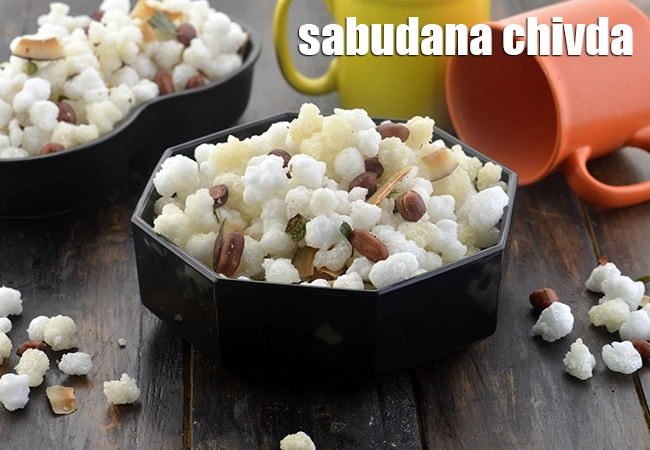
sabudana khichdi | maharashtrian sabudana khichdi | sago khichdi
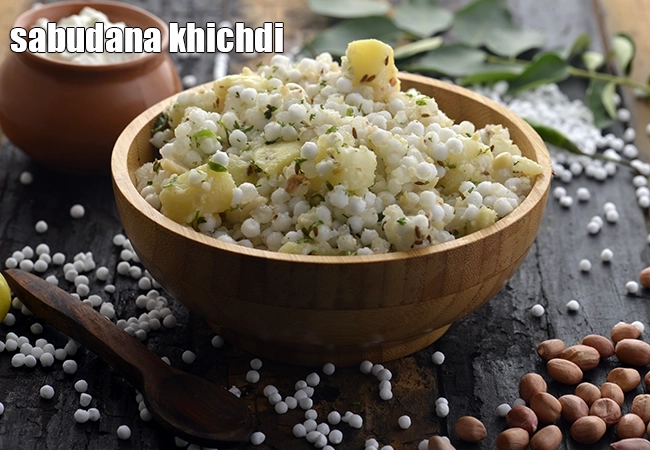
sabudana vada recipe | Maharashtrian sabudana vada | how to make crispy sabudana vada | sago vada

farali misal recipe | upvas misal Indian snack | Maharashtrian upvasachi farali misal | quick upvas snack humble sabudana khichdi transforms into an interesting misal eligible for a fasting day.
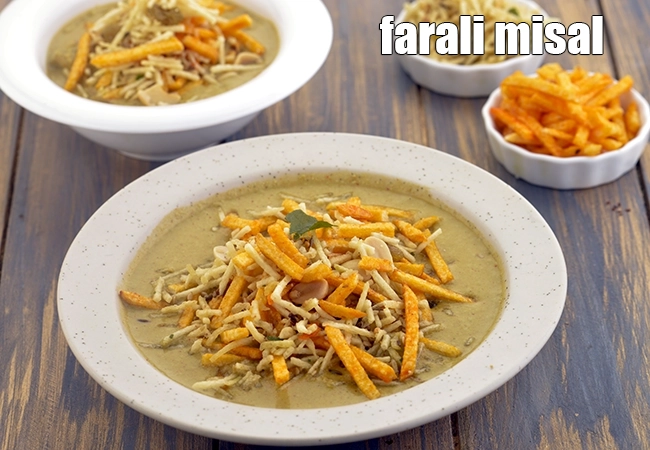
4. Sabudana Thalipeeth | upvas thalipeeth | sago thalipeeth for vrat | Indian farali thalipeeth a sumptuous, traditional Maharashtrian snack, is made in a faraal-friendly way in this recipe.
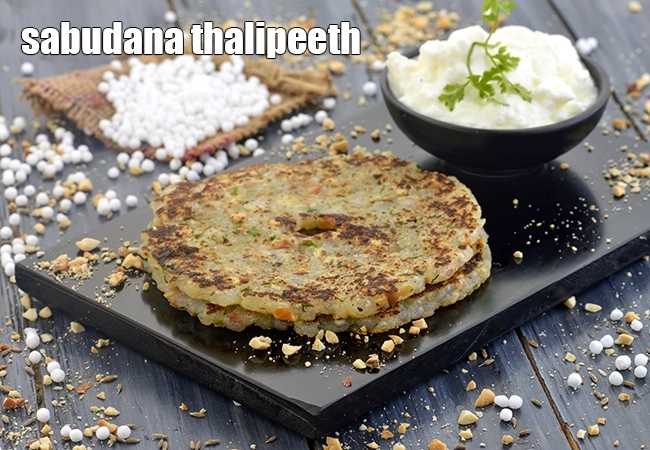
sabudana vermicelli payasam | vermicelli sabudana kheer | vermicelli sago kheer
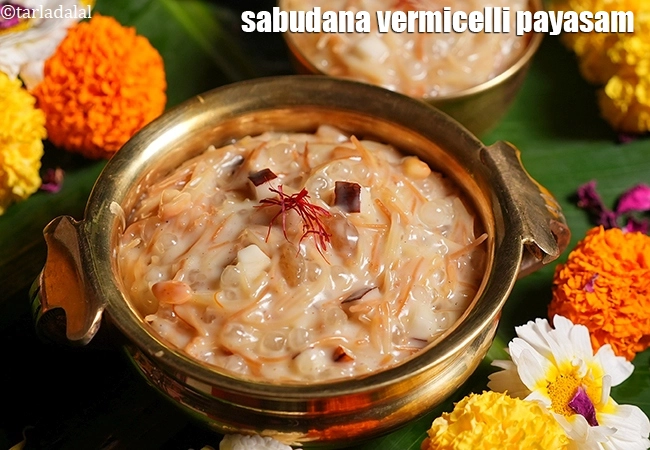
How to Store Sago, Sabudana
• Purchase as needed and do not overstock.
• Keep in an airtight and dry container to stock it for a few weeks or months.
• Do not mix the old and new stock.
• Keep it away from moisture, as even a little water can make the whole thing soggy and unacceptable.
Health Benefits of Sago, Sabudana
• Sago is nearly pure carbohydrate and has very little protein, vitamins, or minerals.
• It can be enriched by the addition of other healthy food options like groundnuts, vegetables, milk etc.
Nutritive Information for Sago (Sabudana):
½ Cup of sago is about 75 grams
RDA stands for Recommended Daily Allowance.
Energy – 176 calories
Protein – 0.1 g
Carbohydrate – 43.7 g
Fat – 0.1 g
Fiber – 0.5 g
Minerals:
10 mg of Calcium = 1% of RDA (about 1000 mg)
0.8 mg of Iron = 4% of RDA (about 20 mg)
7 mg of Phosphorus = 0.16 % of RDA (about 600 mg)
11 mg of Potassium = 0.23% of RDA (about 4700 mg)

soaked sago
Wash the sago pearls in running water without applying too much pressure by hand. Soak them in water or thin buttermilk for an hour. Drain, sprinkle a little water and allow them to soak further for 2-3 hours, sprinkling water once in a while.

Nylon sago

Related Recipes
Sabudana Vada ( Faraal Recipe)
Sabudana Kheer, Indian Dessert For Fasting
Sabudana Vermicelli Payasam Recipe
More recipes with this ingredient...
sago (15 recipes), soaked sago (4 recipes) , Nylon sago (1 recipes)

Related Glossary
Follow US
Recipe Categories
- Vitamin B12 Cobalamin Rich Recipes 33 recipes
- Low Calorie, Weight Loss Indian Recipes 421 recipes
- Low Cholesterol Indian Recipes 308 recipes
- Healthy Indian Breakfast 373 recipes
- Indian Diabetic recipes 559 recipes
- Indian Pregnancy recipes 461 recipes
- Zero Oil Indian Recipes 133 recipes
- Iron Rich Indian recipes 268 recipes
- Healthy Indian Acidity recipes 137 recipes
- Healthy Sabzis 108 recipes
- Indian Healthy Veg Snack 276 recipes
- Healthy Heart Recipes 415 recipes
- Healthy Veg Indian Soups 74 recipes
- Calcium Rich Indian 373 recipes
- High Blood Pressure Indian Recipes 103 recipes
- Healthy Indian Salads Recipes 137 recipes
- Low Carb Indian Diet, recipes 163 recipes
- Hypothyroidism Diet 63 recipes
- Arthritis Diet 68 recipes
- High Protein Indian recipes 95 recipes
- Vitamin K Diet 42 recipes
- Fatty Liver Diet 39 recipes
- PCOS 136 recipes
- Gluten Free Veg Indian 196 recipes
- High Fiber 328 recipes
- Indian Cancer Patients 275 recipes
- Jaundice Diet 45 recipes
- Sprouts 61 recipes
- Typhoid 43 recipes
- Irritable Bowel Syndrome (IBS) 23 recipes
- Kidney Stone Diet 10 recipes
- Home Remedies 213 recipes
- Senior Citizen 195 recipes
- Healthy Indian Drinks and Juices 213 recipes
- Diet for Dialysis 10 recipes
- Gout Indian Recipes 17 recipes
- Potassium Rich 80 recipes
- Vegan 195 recipes
- Indian recipes to treat Vomiting 8 recipes
- Forever Young Diet, Anti Aging Indian Diet 255 recipes
- Antioxidant Rich Indian 445 recipes
- Vitamin B1 Rich Indian Foods, Recipes 101 recipes
- High in Omega 3 Fatty Acids 32 recipes
- Zinc Rich Foods 55 recipes
- Vitamin A Rich, Beta Carotene, Retinol 89 recipes
- Malaria Diet 19 recipes
- Magnesium Rich 94 recipes
- Healthy Indian Dinner 85 recipes
- Vitamin C Rich Indian recipes 118 recipes
- Low Veg Glycemic Index 86 recipes
- Lower Blood Pressure Salads 8 recipes
- Healthy Indian Lunch Recipes 29 recipes
- Lactation 25 recipes
- Vitamin E Rich 51 recipes
- Hyperthyroidism Diet 47 recipes
- Vitamin B3, Niacin Rich 41 recipes
- Post Surgery Diet 42 recipes
- Selenium 27 recipes
- Phosphorus Rich Indian Recipes, Foods 74 recipes
- Lower Blood Pressure Desserts Sweets 14 recipes
- Copper 15 recipes
- Foods Rich in Vitamin B2 Riboflavin 22 recipes
- Vitamin B6 Diet 36 recipes
- B Vitamins 231 recipes
- Vitamin B9 Rich Folate 50 recipes
- Marathoners, Endurance Athletes, Triathlete 225 recipes
- Manganese Diet 32 recipes
- Thalassemia 18 recipes
- Detox Water, Fruit Infused Water 42 recipes
- Lactose Free Dairy Free 22 recipes
- Omega 6 Fatty Acids 32 recipes
- Phytonutrients 51 recipes
- Chronic Kidney Disease Indian recipes 12 recipes
- Selenium1 0 recipes
- Quick Snacks / Quick Starters 385 recipes
- Quick Breakfast Indian 131 recipes
- Quick Sabzis 117 recipes
- Quick Rotis / Parathas 46 recipes
- Quick Indian Sweets 139 recipes
- Quick Stir-Fries 51 recipes
- Quick Vegetarian Indian Soups 72 recipes
- Quick Chutneys 67 recipes
- Quick Vegetarian Rice, khichdi Recipes 56 recipes
- Indian Snacks Under 10 Minutes (Quick Veg Recipes) 44 recipes
- Quick Indian Dips, Gravies & Sauces 105 recipes
- Quick Veg Indian Pizza 17 recipes
- Quick Veg Pasta 25 recipes
- Quick Pickles / Aachar 25 recipes
- Quick Dals / quick Kadhis 29 recipes
- Snacks under 5 minutes 33 recipes
- Quick Healthy Recipes 43 recipes
- Quick Pressure Cooker 46 recipes
- Quick Desserts 47 recipes
- Quick 3 Ingredients 63 recipes
- Quick Indian Desserts 20 recipes
- Quick 4 Ingredients 41 recipes
- Quick 5 Ingredients 42 recipes
- Kids Tiffin Box 319 recipes
- Recipes for Toddlers (1-3 Years) 32 recipes
- Sweet Recipes for Kids 456 recipes
- Recipes for Baby (10 to 12 Months) 17 recipes
- Quick Indian recipes for Kids 72 recipes
- Indian Breakfast Recipes for Kids 192 recipes
- Recipes for Weaning (8 to 9 months) 22 recipes
- Healthy Foods for Kids 196 recipes
- Snack Recipes for Kids 619 recipes
- Recipes Kids can make 36 recipes
- Kids After School 794 recipes
- Kids Jar Snacks 66 recipes
- Finger Foods for Babies, Toddlers and Kids 76 recipes
- Kids Weight Gain 43 recipes
- Kids Wraps and Rolls 23 recipes
- Kids Veg Pasta 27 recipes
- Kids Brain Boosting 68 recipes
- Protein rich food for kids 71 recipes
- Recipes for Weaning 15 recipes
- Kids Pizzas 30 recipes
- Babies, Toddler and Kids Iron Rich Foods 31 recipes
- High Fiber Foods for Kids 39 recipes
- Kids High Energy Indian Foods 103 recipes
- Kids Noodles 37 recipes
- Kids Calcium Rich Indian recipes 92 recipes
- Babies recipes, 6 to 18 months 34 recipes
- Kids Recipes for Increasing Immunity 10 recipes
- Kids Weight Loss 58 recipes
- Teething Recipes for Babies 10 recipes
- Cereals and Pulses for 8 to 9 months Baby 8 recipes
- Weaning foods at 7 months 12 recipes
- Indian Teen 315 recipes
- Starters / Snacks 2138 recipes
- Indian Breakfast Recipes 819 recipes
- Main Course Recipes 925 recipes
- Indian Salads 385 recipes
- Indian Desserts , Sweets 985 recipes
- Indian Soups 249 recipes
- Indian Beverages, Indian Drinks 483 recipes
- Indian Dinner 903 recipes
- Indian Dinner1 0 recipes
- Indian Lunch 829 recipes
- Side Dishes 449 recipes
- Indian Travel Food 433 recipes
- Indian Barbeque1 recipes 22 recipes
- Frozen Foods, Indian Freezer Recipes 67 recipes
- Whole Wheat Recipes 56 recipes
- Indian Comfort Foods 212 recipes
- Dinner Menus 56 recipes
- Easy Indian Veg 70 recipes
- Innovative Indian Recipes 27 recipes
- No Cook Indian 37 recipes
- Advanced Recipes 10 recipes
- Cakes with Eggs 13 recipes
- Microwave 229 recipes
- Oven 619 recipes
- Indian Steamer Recipes 102 recipes
- Kadai Veg 407 recipes
- Indian Barbeque Recipes 43 recipes
- Sizzler tray 15 recipes
- Mixer 566 recipes
- Pressure Cooker 315 recipes
- Tava 647 recipes
- Non-stick Pan 1393 recipes
- Indian Freezer recipes, meals 57 recipes
- Appe Mould 18 recipes
- Pan 223 recipes
- Non Stick Kadai Veg 203 recipes
- kadai Indian 150 recipes
- Refrigerator 176 recipes
- Waffle Indian recipes 6 recipes
- Handi 12 recipes
- Juicer and Hopper 65 recipes
- Grill 31 recipes
- Toaster 21 recipes
- Gas Toaster 8 recipes
- Steam 72 recipes
- No Cooking Veg Indian 335 recipes
- Vegetarian baked Indian recipes 380 recipes
- Boiled Indian recipes 129 recipes
- Deep Fry 260 recipes
- Indian Tawa 265 recipes
- Shallow Fry Indian 25 recipes
- Microwave1 172 recipes
- Saute 273 recipes
- Indian Pressure Cooker 171 recipes
- Stir-fry 101 recipes
- Roasting 0 recipes

















